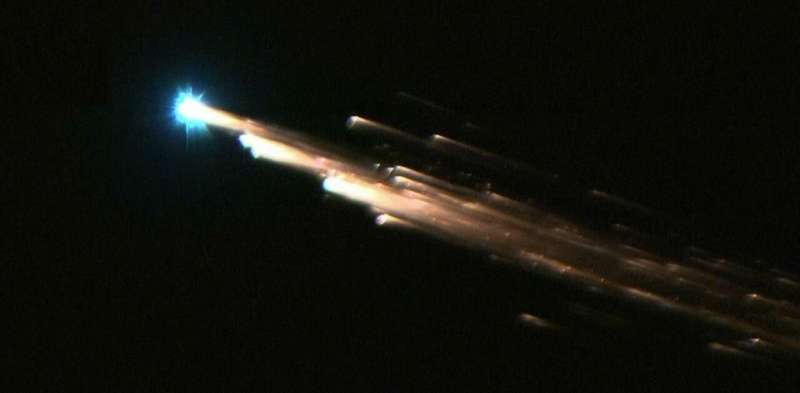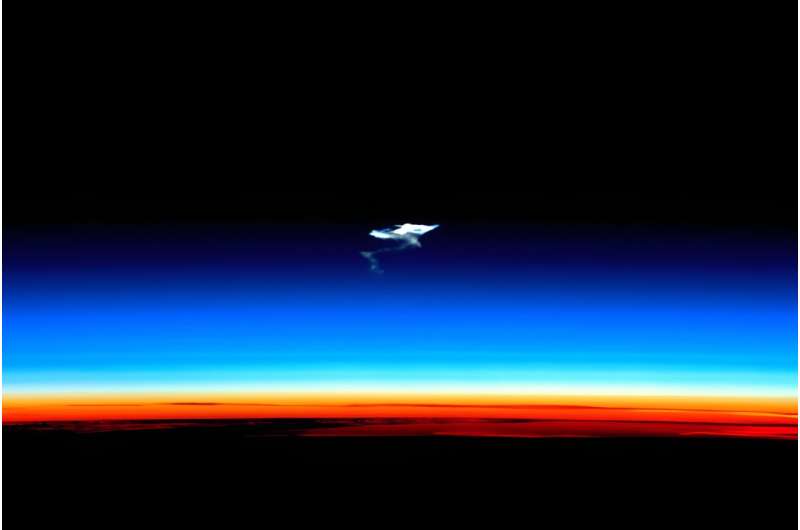Credit: ESA
Communications companies such as Starlink plan to launch tens of thousands of satellites into orbit around Earth over the next decade or so. The growing swarm is already causing problems for astronomers, but recent research has raised another question: What happens when they start to come down?
When these satellites reach the end of their useful life, they will fall into Earth's atmosphere and burn up. Along the way, they will leave a trail of tiny metallic particles.
According to a study published last week by a team of American researchers, this satellite rain may dump 360 tons of tiny aluminum oxide particles into the atmosphere each year. The aluminum will mostly be injected at altitudes between 50 and 85 kilometers, but it will then drift down to the stratosphere—home to Earth's protective ozone layer.
What does that mean? According to the study, the satellite's contrail could facilitate ozone-destroying chemical reactions. That's not wrong, but as we will see, the story is far from simple.
How does ozone get destroyed?
Ozone loss in the stratosphere is caused by "free radicals"—atoms or molecules with a free electron. When radicals are produced, they start cycles that destroy many ozone molecules. (These cycles have names Dr. Seuss would admire: NOx, HOx, ClOx and BrOx, as all involve oxygen as well as nitrogen, hydrogen, chlorine and bromine, respectively.)
These radicals are created when stable gases are broken up by ultraviolet light, which there is plenty of in the stratosphere.
Nitrogen oxides (NOx) start with nitrous oxide. This is a greenhouse gas naturally produced by microbes, but human fertilizer manufacturing and agriculture has increased the amount in the air.
The HOx cycle involves hydrogen radicals from water vapor. Not much water vapor makes it into the stratosphere, though events like the Hunga Tonga–Hunga Ha'apai underwater volcanic eruption in 2022 can sometimes inject large amounts. Water in the stratosphere creates numerous small aerosol particles, which create a large surface area for chemical reactions and also scatter more light to make beautiful sunsets. (I will come back to both of these points later.)
The plume left by the re-entry of the Soyuz capsule in 2015, as photographed from the International Space Station. Credit: NASA / Scott Kelly
How CFCs made the 'ozone hole'
ClOx and BrOx are the cycles responsible for the most famous damage to the ozone layer: the "ozone hole" caused by chlorofluorocarbons (CFCs) and halons. These chemicals, now banned, were commonly used in refrigerators and fire extinguishers and introduced chlorine and bromine to the stratosphere.
CFCs rapidly release chlorine radicals in the stratosphere. However, this reactive chlorine is quickly neutralized and locked up in molecules with nitrogen and water radicals.
What happens next depends on aerosols in the stratosphere, and near the poles it also depends on clouds.
Aerosols speed up chemical reactions by providing a surface for them to occur on. As a result, aerosols in the stratosphere release reactive chlorine (and bromine). Polar stratospheric clouds also remove water and nitrogen oxides from the air.
So, in general, when there are more stratospheric aerosols around we are likely to see more ozone loss.
Provided by The Conversation
This article is republished from The Conversation under a Creative Commons license. Read the original article.![]()

























